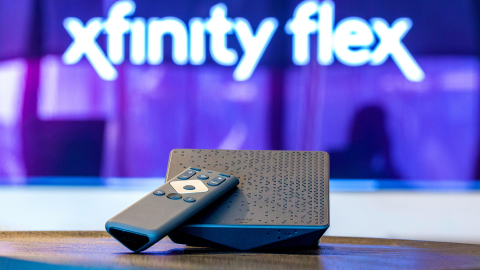Is Comcast Getting Ready to Expand Xfinity Flex Out of Footprint?
With cable operator announcing Flex device support for its Xfinity Stream app Thursday, speculation heats up that it will soon follow through on talks to port the platform into smart TVs sold by Walmart

Is Comcast going to follow through on reported talks with Walmart to distribute the cable operator’s Xfinity Flex connected TV device platform in smart TVs sold out of footprint?
With the operator saying Thursday that its Xfinity Stream pay TV app is now supported by Xfinity Flex, speculation is heating up.
“Over many years, you can try to squeeze out some of the competitors simply by moving up the distribution channel. So basically [Comcast would be] making a TV that doesn't allow a Roku stick to go in,” said Todd Krizelman, founder and CEO of advanced advertising company MediaRadar, speaking at a Thursday virtual panel discussion.
Comcast NBCUniversal debuted its hybrid AVOD/SVOD streaming service, Peacock, nationally back in mid-July. But quietly, it exclusively incubated the streaming service on its Xfinity X1 and Flex pay TV platforms starting in mid-April of last year, and was reportedly thrilled with the advanced advertising experiments it was able to conduct by controlling the device platform Peacock ran on, and all the data that came with that.
Concurrently, Roku has been quietly amassing scale in the connected TV device ecosystem and threatening to run away with the game ball. Roku announced 51.2 million active accounts as of the end of 2020. LightShed principal analyst Richard Greenfield speculated in a Thursday blog post that Roku is quietly developing dominance in the connected TV advertising market. Soon, he pondered, there might be a paradigm in which advertisers buy inventory directly from Roku, and not media companies like Comcast/NBCUniversal/Peacock. Greenfield headlined his post, “Is Roku Using a Trojan Horse to Devour the TV Ad Market?”
The active Thursday was punctuated by Comcast’s news that the Xfinity Stream app is now available on Flex devices. Flex is a thin-client OTT streaming device that Comcast hands out for free to its broadband-only customers.
The device lets these customers stream popular apps like Netflix and YouTube. But Flex users can also sign up for the full Comcast Xfinity X1 pay TV service and enjoy X1, complete with voice control, using the Flex device.
The smarter way to stay on top of the streaming and OTT industry. Sign up below.
If they do that, their Flex gadget effectively becomes an X1 set-top, running over Comcast's managed network. The ability to run Xfinity Stream allows these users to keep the native Flex app-based OS, while still having the option to subscribe and use Comcast pay TV services in app form.
We asked a Comcast rep, might this be a precursor to taking Flex out of footprint?
“No, we’re doing this to give our internet customers with Flex an easy way to upgrade to our TV service and stay within the Flex experience,” the rep responded.
During Comcast’s fourth quarter earnings call in January, Comcast’s top executives admitted that an announcement regarding expanded ambition for Flex was coming.
“There are opportunities, including smart TVs, that could leverage scale,” said Comcast Cable CEO Dave Watson. “Right now, it’s looking great in our footprint, but we’re making plans beyond that, whether it’s a device or software solution."
Added Comcast CEO Brian Roberts: “I think we’ll have more to talk about throughout the year.”
The fact that Comcast is telling investors this, and not the press, has piqued interest from observers like Krizelman.
He noted Thursday, “That to me is interesting to hear the way they talked about it with investors, not to consumers or in trade press, but in their [earnings] calls. I think there's some positioning in the macro perspective that I do wonder if how it is that suddenly this business of manufacturing TV is somehow more important than ever. It's not necessarily just a game for Samsung or for the people who we normally associate.
“If you said we could sell a lot of television sets against Roku and against Android and others, you essentially can slowly over many years cause people to replace TV sets…,” Krizelman said.
